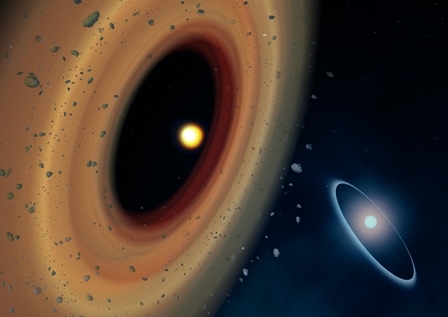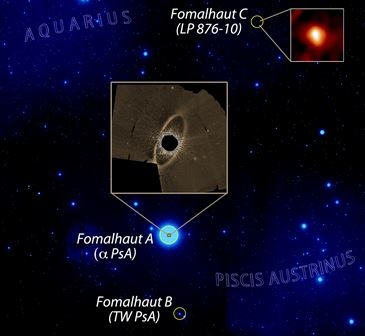
The new discovery of a second cometary ring in the triple stellar system, made using the Herschel telescope, could lead to a better understanding of exoplanetary systems. According to theory, it should be composed of both a family of planets and, on the edge of the system, and the debris left over from their formation, like the Kuiper belt in the Solar system. Of course, this theory was tailored essentially to fit our planetary system, and astronomers are now trying to show that it could have universal validity. However, numerous exo-Jupiters are being found around stars with no cometary rings and, conversely, stars with rings are often lacking in exo-Jupiters. It has also been shown that most exoplanets are on excentic orbits (i.e. their orbits are not circular), as is the case for most of the planets in the Solar System.
The discovery of the ring around Fomalhaut C could help solve this mystery. It turns out that the orbits of the comets and the exoplanet around Fomalhaut A are relatively excentic. This type of orbit can be easily induced by close encounters between stars in a triple stellar system. The danse of three stars under the influence of gravity involves set figures : the stars approach each other, draw apart to a large distance, before skimming past each other once again. Moreover, in this danse, close encounters induce, because of the omnipresent gravitational fields, collisions between comets, producing large quantities of dust which renders the ring observable.

According to this scenario, a cometary ring becomes observable only after a grazing encounter with another star. Once the motion of Fomalhaut C with respect to Fomalhaut A has been determined precisely in the years to come, this idea could be tested with numerical simulation for time scales on the order of several million years, which corresponds to the periodicity of the system. Why no cometary ring has been found around Fomalhaut B is still not understood : the question will be investigated by measuring its motion with respect to the other two stars, which might well reveal, as suggested by the scenario, that a close stellar encounter has never occurred in this case.
This discovery could stimulate new work on the Fomalhaut system. It will probably have a more general impact on our understanding of the architecture of exoplanetary systems.
Know more
Fomalhaut A is one of the brightest stars in the sky. It is 25 light years away, in the constellation of the Piscis Austrinus, ; it is in the Southern hemisphere, but is visible in the Northern hemisphere in autumn, low on the horizon ; it shines with an unmistakable blue colour. On the other hand, Fomalhaut C, also known as LP 876-10, is a dim red dwarf which can only be seen with a good telescope ; its membership of the Fomalhaut system was a recent discovery dating from October 2013. The bright star Fomalhaut A was a prime target for the Hubble Space Telescope, and astronomers were delighted to discover that the star is surrounded by a magnificent ring of light, scattered by the dust coming from its comets. In 2008, they were astounded by the discovery, in the astronomical image, of an exoplanet situated close the the inner edge of the ring. While on the order of a thousand exoplanets have been discovered by indirect methods, to date only three stars have been shown to have exoplanets using direct imagery.
